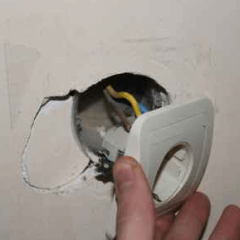Which cable to choose for connecting outlets?
So, to begin with, according to modern requirements, the cable for outlets must be copper, always with grounding (i.e. three-wire or five-wire) and a cross section of at least 1.5 mm2 according to the PUE table 7.1.1:
Here it should be clarified that a group network means a line from shields to power sockets, lighting devices and other power receivers.
Now it’s become a little clearer which cable to use for the installation of a 220-volt outlet line. It should also be noted that lay a cable with a cross section of 1.5 mm from the junction box to the outlet2 not advisable since in this case, connecting a powerful electric device to it will not work, if necessary. It is better for a single-phase network to take a section with a margin of 2.5 mm2.
As for the three-phase wiring, things can already be different, because with a cross section of a core of 1.5 mm2 a five-core cable is able to withstand a load of 10.5 kW, according to the table:
This is enough to connect powerful electrical equipment used at home to the outlet. However, as experience shows, even in a network with a voltage of 380 volts, the conductor is taken with a margin, namely, a cross section of 2.5 mm2.
We figured out the thickness of the conductive wires, now let's talk about another, no less important issue - which type and brand of conductor to choose. The fact is that today there are a large number of fakes, the use of which can cause ignition of electrical wiring. Same PUNP wire is dangerous for electrical installation. We recommend that you use VVG, VVGNG, or NYM cable for sockets.
If you want to conduct wiring for an outlet group in an apartment or a private house, just select the brand VVG. In fire hazardous areas, for example, in a wooden house, we definitely recommend using it for outlets VVGng cable or its more expensive imported counterpart - NYM.
That was all I wanted to tell you on this matter. To consolidate the material provided, we decided to summarize and once again indicate which brand of cable and cross-section is better to use for outlets in different cases:
- For connecting a washing machine, TV and other not very powerful household electrical appliances - VVG 3 * 2.5 mm2.
- To connect powerful appliances in a three-phase network (for example, if in the garage you need to connect a powerful pump to 380 volts or in the kitchen a three-phase stove) - VVG 5 * 2.5 mm2.
- Rosette group in a wooden house - VVGng 3 * 2.5 mm2.
- If you are 100% sure that the socket will be used exclusively to power the lamp or other low-power device, you can bring a conductor with a cross section of 3 * 1.5 mm2.
Finally, we recommend watching a useful video on the topic:
Now you know which cable for sockets to choose by section and name. If you liked the article, please share useful information with your friends on social networks!











